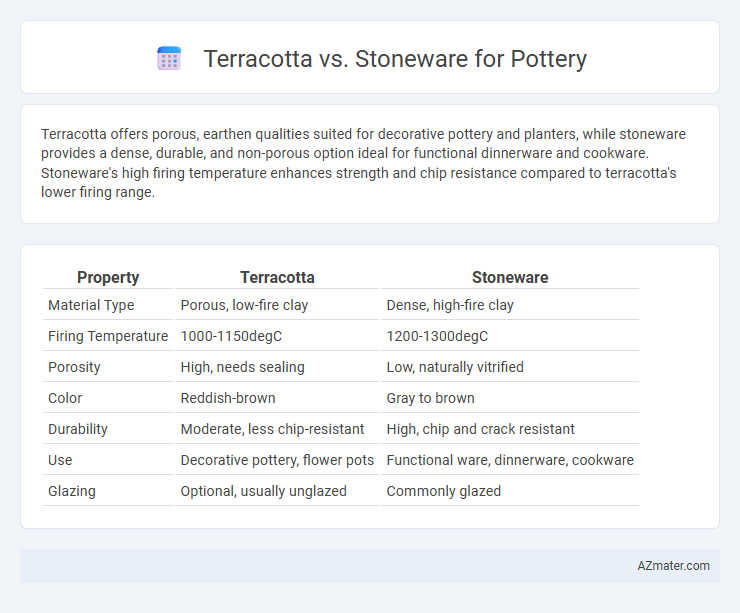Terracotta offers porous, earthen qualities suited for decorative pottery and planters, while stoneware provides a dense, durable, and non-porous option ideal for functional dinnerware and cookware. Stoneware's high firing temperature enhances strength and chip resistance compared to terracotta's lower firing range.
Table of Comparison
| Property | Terracotta | Stoneware |
|---|---|---|
| Material Type | Porous, low-fire clay | Dense, high-fire clay |
| Firing Temperature | 1000-1150degC | 1200-1300degC |
| Porosity | High, needs sealing | Low, naturally vitrified |
| Color | Reddish-brown | Gray to brown |
| Durability | Moderate, less chip-resistant | High, chip and crack resistant |
| Use | Decorative pottery, flower pots | Functional ware, dinnerware, cookware |
| Glazing | Optional, usually unglazed | Commonly glazed |
Introduction: Understanding Terracotta and Stoneware
Terracotta is a porous, reddish clay fired at lower temperatures, known for its rustic appearance and breathability, making it ideal for decorative pottery and garden planters. Stoneware, fired at higher temperatures, is dense and non-porous with a glass-like finish, offering durability and resistance to chipping, suitable for dinnerware and functional ceramics. Understanding the differences in composition, firing temperature, and use helps artists choose the best material for their pottery projects.
Composition and Material Differences
Terracotta clay consists primarily of iron-rich natural clay fired at lower temperatures, resulting in a porous, reddish-brown ceramic ideal for decorative pottery. Stoneware is made from denser, kaolin-rich clay minerals and fired at higher temperatures, producing non-porous, durable ceramics with a varied color palette from grey to brown. The higher firing temperature of stoneware enhances vitrification, making it more resistant to water and mechanical stress compared to terracotta.
Firing Temperatures and Methods
Terracotta typically fires at lower temperatures between 1,000degC and 1,150degC, resulting in a porous, matte finish that is ideal for decorative pottery but less durable for functional ware. Stoneware is fired at higher temperatures, around 1,200degC to 1,300degC, producing a dense, vitrified, and non-porous surface suitable for functional and durable pottery. The firing method for terracotta often involves oxidation atmospheres, while stoneware may be fired in oxidation or reduction atmospheres to achieve various surface effects and material characteristics.
Durability and Strength Comparison
Terracotta pottery is porous and less durable, making it more prone to chipping and cracking compared to stoneware, which is fired at higher temperatures resulting in a denser, stronger material. Stoneware offers superior strength and resistance to thermal shock, ideal for functional pottery such as dinnerware and cookware. The vitrification process in stoneware creates a non-porous surface, enhancing its longevity and making it more suitable for everyday use than terracotta.
Water Absorption and Porosity
Terracotta pottery exhibits higher water absorption and greater porosity due to its low firing temperature, typically between 1,000 to 1,150degC, resulting in a more porous and less durable material. Stoneware, fired at higher temperatures ranging from 1,200 to 1,300degC, has significantly lower water absorption rates, often below 3%, making it denser, more vitrified, and more resistant to moisture penetration. These differences in porosity and water absorption directly impact the suitability of terracotta for decorative use and stoneware for functional, moisture-sensitive applications.
Aesthetic Qualities: Color and Texture
Terracotta pottery is characterized by its warm, earthy reddish-brown hues and a porous, matte texture that enhances a rustic, natural aesthetic. Stoneware offers a broader color range from light gray to deep brown, featuring a denser, smoother surface with a subtle sheen that lends a refined and durable appearance. Both materials provide distinct tactile and visual qualities, with terracotta emphasizing organic warmth and stoneware delivering sleek sophistication.
Uses and Ideal Pottery Applications
Terracotta pottery, known for its porous nature and warm reddish-brown color, is ideal for decorative planters, rustic tableware, and traditional garden pots due to its breathable properties that allow moisture evaporation. Stoneware offers greater durability and non-porous qualities, making it perfect for functional kitchenware such as dinner plates, mugs, and baking dishes that require resistance to chipping and high temperatures. The choice between terracotta and stoneware depends on whether aesthetic appeal and breathability (terracotta) or strength and versatility in food-safe applications (stoneware) are prioritized.
Cost and Accessibility for Potters
Terracotta clay is generally more affordable and widely accessible compared to stoneware, making it a popular choice for beginner potters and those on a budget. Stoneware requires higher firing temperatures and more specialized kilns, increasing both initial investment and operational costs. The availability of terracotta materials locally also reduces shipping expenses, enhancing cost-effectiveness for small-scale pottery production.
Maintenance and Longevity
Terracotta pottery requires regular sealing and careful handling to prevent moisture absorption and cracking, making its maintenance more intensive compared to stoneware. Stoneware is highly durable and naturally dense, offering superior resistance to chipping, water, and temperature changes, which extends its longevity with minimal upkeep. Choosing stoneware ensures longer-lasting pottery with less frequent maintenance, ideal for both functional and decorative uses.
Choosing Between Terracotta and Stoneware
Selecting between terracotta and stoneware depends on the vase's intended use and aesthetic preference; terracotta offers a porous, earthy texture ideal for rustic, breathable pottery, while stoneware provides a dense, non-porous surface suited for durable, functional pieces. Terracotta's low firing temperature (around 1000degC) results in a softer, reddish clay body, contrasted with stoneware's higher firing temperature (1200-1300degC) that creates a vitrified, chip-resistant finish. For outdoor gardening or decorative, lightweight items, terracotta excels, whereas for kitchenware requiring strength and water resistance, stoneware is preferable.

Infographic: Terracotta vs Stoneware for Pottery
 azmater.com
azmater.com